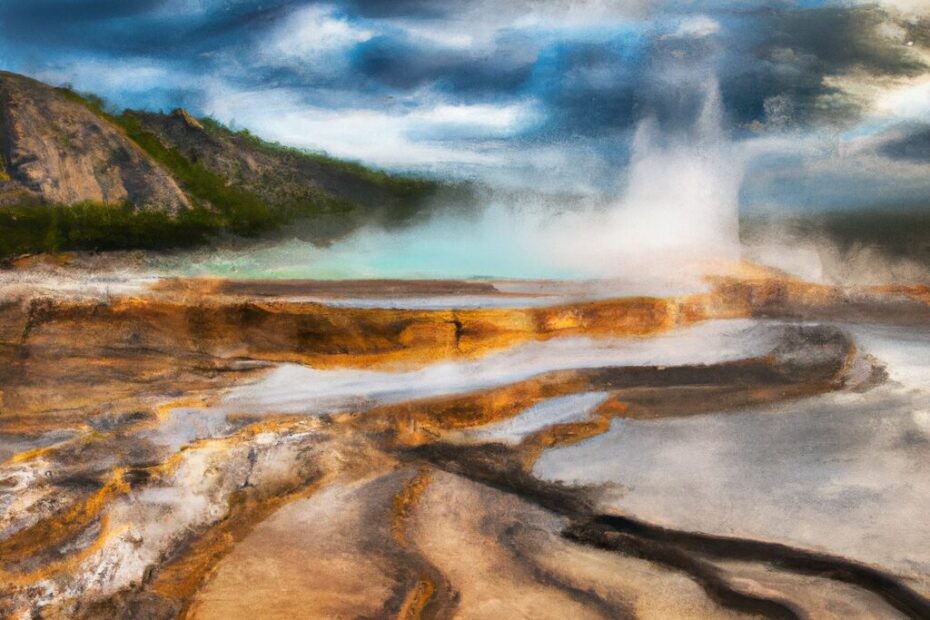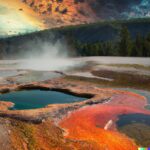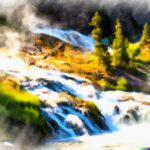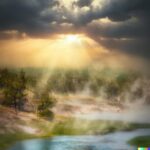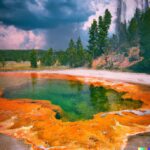Yellowstone National Park is not only a stunning natural wonder, but also a hotspot for geothermal activity. Magma chambers and underground heat sources play a crucial role in shaping the park’s unique landscape and geothermal features.
In this article, we will explore how magma chambers are formed, the geothermal features of Yellowstone, and how these underground heat sources contribute to the park’s geothermal activity. We will also discuss the potential dangers of magma chambers and heat sources, as well as how scientists are monitoring and predicting future geothermal activity in Yellowstone.
What Are Magma Chambers?
Magma chambers are underground reservoirs beneath volcanoes like Yellowstone that hold molten rock, playing a crucial role in various geological processes and shaping the region’s rich geologic history.
These chambers are formed through the accumulation of magma from deep within the Earth’s mantle, feeding the volcanic systems above. As the magma rises, it can trigger volcanic eruptions, creating lava flows, ash clouds, and pyroclastic flows. The composition of magma within these chambers varies, influencing the type of volcanic activity observed.
By studying these chambers, geologists gain insights into the history and behavior of volcanoes, aiding in the prediction of future eruptions and contributing to our understanding of the dynamic processes that shape the Earth’s surface.
How Are Magma Chambers Formed?
The formation of magma chambers is a complex process influenced by volcanic activity, geologic modeling, and the intricate interactions of magmatic systems within the Earth’s crust.
Volcanic activity plays a crucial role in the development of magma chambers, as it provides the necessary heat and pressure for the formation of molten rock beneath the Earth’s surface.
Geologic modeling techniques help scientists understand the subsurface structures and composition, allowing them to predict the locations and sizes of potential magma reservoirs.
The behavior of magmatic systems, such as the movement of magma and differentiation processes, also contributes to the creation of these underground reservoirs. By combining these factors, researchers gain valuable insights into the dynamics of magma chamber formation and the associated volcanic hazards.
What Is Yellowstone National Park?
Yellowstone National Park is a renowned geothermal wonderland with unique geologic features, showcasing the park’s thermal evolution and diverse geologic structure.
The extensive geothermal activity in the park is evident through its geysers, hot springs, and mud pots, all fueled by the underlying volcanic processes. Over millions of years, the thermal features have evolved, creating a landscape rich in colorful mineral deposits and unique hydrothermal formations.
The park’s geological diversity is highlighted by the Yellowstone Caldera, a massive crater formed by past volcanic eruptions, which now serves as a striking reminder of the region’s turbulent geological history. This unique combination of geothermal prominence and geological complexity makes Yellowstone a one-of-a-kind destination for nature enthusiasts and researchers alike.
What Are The Geothermal Features Of Yellowstone?
The geothermal features of Yellowstone include thermal anomalies, hydrothermal systems, and unique geological structures that highlight the park’s exceptional geothermal characteristics.
Visitors to Yellowstone National Park can witness a remarkable display of geothermal activity through steaming geysers, bubbling hot springs, and vividly colored microbial mats. These thermal anomalies provide a glimpse into the Earth’s internal processes, showcasing the power of geothermal energy.
The hydrothermal systems in the park create a dynamic landscape, with features like fumaroles and mud pots dotting the terrain. The combination of these geothermal phenomena contributes to the park’s status as a prime location for studying the complexities of geothermal systems and their impact on Earth’s geology.
How Do Magma Chambers And Underground Heat Sources Contribute To Yellowstone’s Geothermal Activity?
Magma chambers and underground heat sources play a pivotal role in fueling Yellowstone’s geothermal activity, influencing the region’s thermal landscape and providing valuable insights through techniques like thermal imaging.
The interaction between these underground forces and the surface manifestations at Yellowstone National Park creates a dynamic environment where hot springs, geysers, and fumaroles are sustained by the subterranean heat. The intricate connections between the magma chambers and the geothermal features in the park demonstrate the complex geological processes at play. By utilizing thermal imaging technology, researchers can capture the thermal signatures of these phenomena, aiding in the understanding of the underlying mechanisms driving the park’s unique thermal dynamics.
What Is The Role Of Magma Chambers In Yellowstone?
Magma chambers in Yellowstone play a crucial role in shaping the park’s geothermal landscape, influencing geothermal exploration efforts, showcasing dynamic magma flow dynamics, and prompting in-depth geologic investigations.
These deep pockets of molten rock serve as the heart of Yellowstone’s geothermal activity, providing a window into the inner workings of the Earth’s crust. By studying these chambers, researchers gain insight into the pathways of volcanic material below the surface and how it interacts with the geothermal features above ground. The presence of magma chambers not only fuels the spectacular geysers and hot springs for which Yellowstone is famous but also serves as a catalyst for ongoing scientific inquiry and innovation in the field of geothermal exploration.
What Other Underground Heat Sources Are Present In Yellowstone?
Aside from magma chambers, Yellowstone hosts various underground heat sources that contribute to the park’s thermal evolution, engage in essential heat transfer processes, and are critical for geothermal resources assessment.
- These diverse underground heat sources include hydrothermal systems, geysers, hot springs, and fumaroles.
- Hydrothermal systems, in particular, play a significant role in maintaining Yellowstone’s thermal features as they circulate hot water through the subsurface.
- Geysers, such as the iconic Old Faithful, are powered by underground heat sources that drive the eruption of boiling water and steam.
- Hot springs are formed when groundwater is heated by these underground sources and then rises to the surface.
- Fumaroles release gases and steam, offering valuable insights into the deeper volcanic processes at play.
How Do These Heat Sources Affect The Geothermal Activity In Yellowstone?
The identified heat sources significantly impact the geothermal activity in Yellowstone by influencing geothermal gradients, guiding geologic mapping efforts, and providing valuable insights for mitigating geothermal hazards.
These heat sources, ranging from magma chambers beneath the surface to hydrothermal systems, create the varying temperatures and pressures that shape the thermal gradients within the park’s geothermal features.
By understanding these gradients, scientists can map out the underlying geology more accurately, revealing important details about the thermal reservoirs and potential eruption zones. This knowledge plays a crucial role in predicting and managing geothermal hazards, such as geyser eruptions or hydrothermal explosions, helping to safeguard both visitors and the unique ecosystem of Yellowstone.
What Are The Potential Dangers Of Magma Chambers And Underground Heat Sources In Yellowstone?
Magma chambers and underground heat sources in Yellowstone pose potential dangers such as volcanic hazards and geologic risks, highlighting the importance of proactive geologic hazards prevention and effective geothermal reservoir management.
Understanding the complexity of these underground heat sources is crucial in mitigating the associated risks. Volcanic hazards can result from the pressure buildup within magma chambers, leading to potential eruptions that can have devastating consequences on the surrounding area. Geologic risks, such as ground instability and seismic activity, also pose significant threats.
Implementing strategies like regular monitoring, early warning systems, and land use planning can help prevent or minimize the impact of these hazards. Efficient management of geothermal reservoirs is essential to ensure sustainable energy extraction while safeguarding the environment.
Can Magma Chambers Cause Volcanic Eruptions In Yellowstone?
The presence of magma chambers raises concerns about volcanic eruptions in Yellowstone, prompting geologic constraints and continuous volcanic monitoring efforts to assess potential volcanic activity.
Magma chambers beneath Yellowstone National Park serve as reservoirs of molten rock, with the potential to fuel explosive volcanic eruptions. Geologic constraints, such as the type of rock and the depth of the chamber, play a significant role in determining the eruption patterns and intensity of volcanic events.
Ongoing volcanic monitoring through techniques like seismology and gas measurements is crucial to track any signs of volcanic unrest, allowing scientists to issue timely warnings and mitigate potential risks to surrounding communities.
What Are The Risks Of Underground Heat Sources In Yellowstone?
Underground heat sources in Yellowstone present risks related to geologic investigations, necessitate efficient responses to geothermal hazards, and demand an understanding of the complex geologic properties associated with such heat sources.
These underground heat sources, often found in the form of geysers, hot springs, and fumaroles, can pose significant dangers due to their potential for sudden eruptions, landslides, or ground instability. Comprehensive geologic investigations are crucial to identify potential weaknesses in the Earth’s crust that could lead to geothermal threats.
Understanding the geological characteristics of these heat sources, such as rock composition, fault lines, and thermal gradients, is vital for predicting and mitigating the risks they pose to both the environment and human infrastructure.
How Are Scientists Monitoring Magma Chambers And Underground Heat Sources In Yellowstone?
Scientists employ advanced techniques like geophysical imaging to monitor magma chambers and underground heat sources in Yellowstone, studying geologic features and assessing geothermal power generation potentials.
These cutting-edge methods involve using various instruments such as ground-based seismometers, GPS sensors, and satellite-based radar to capture seismic activity and ground deformation patterns. By analyzing the data collected from these instruments, researchers can create detailed models of the subsurface conditions, allowing them to track the movement of magma and anticipate potential volcanic eruptions. The exploration of geothermal energy possibilities in Yellowstone involves tapping into the abundant underground heat to generate sustainable power, contributing to the growing interest in renewable energy sources.
What Techniques Are Used To Detect Changes In Magma Chambers?
Various sophisticated techniques such as geophysical methods are leveraged to detect changes in magma chambers, analyzing the underlying geologic structure and exploring potential geothermal utilization opportunities.
Geophysical methods play a crucial role in this process, with techniques like seismic surveys, magnetotellurics, and gravity measurements providing valuable insights into the subsurface dynamics. By closely monitoring seismic activity and changes in resistivity and gravity anomalies, scientists can track magma movements and potential volcanic eruptions. Examining the surrounding geologic structure helps in understanding how the magma chambers interact with the surrounding rocks and minerals. These insights not only aid in predicting volcanic activity but also hold significant implications for geothermal energy exploration and harnessing the Earth’s natural heat for sustainable energy production.
How Can Scientists Predict Future Geothermal Activity In Yellowstone?
Scientists predict future geothermal activity in Yellowstone by conducting in-depth geophysical surveys, analyzing the region’s geologic history, and forecasting geothermal energy production possibilities.
- These geophysical surveys involve measurements of parameters like heat flow, seismic activity, and ground deformation.
- By studying the patterns and trends in these data, scientists can detect changes in the subsurface activity indicative of potential volcanic eruptions or geothermal events.
Examining Yellowstone’s geologic past provides valuable insights into the park’s volcanic history and the likelihood of future eruptions. This historical context, combined with modern geophysical techniques, helps researchers to better understand the dynamics of geothermal systems in the area and assess their potential for sustainable energy production.
Last Updated on February 7, 2024 by Jon Waraas – Originally Posted: February 7, 2024

I’m Jon Waraas, and I’ve been navigating the online world since 2006. By day, I’m the proud owner of some eCommerce gems, and by night, I’m the voice behind the adventures on Waraas.Com.
My heart, however, belongs to the wild beauty of Yellowstone National Park. I’ve got a collection of websites dedicated to sharing the wonders of this natural masterpiece. Oh, and did I mention? I’m currently building my own cabin inside the ghost town of Gilmore, Idaho – a cabin with tales to tell!
When I’m not immersed in the digital realm, you’ll find me lacing up my boots for a good hike or setting up camp under the star-studded sky.
